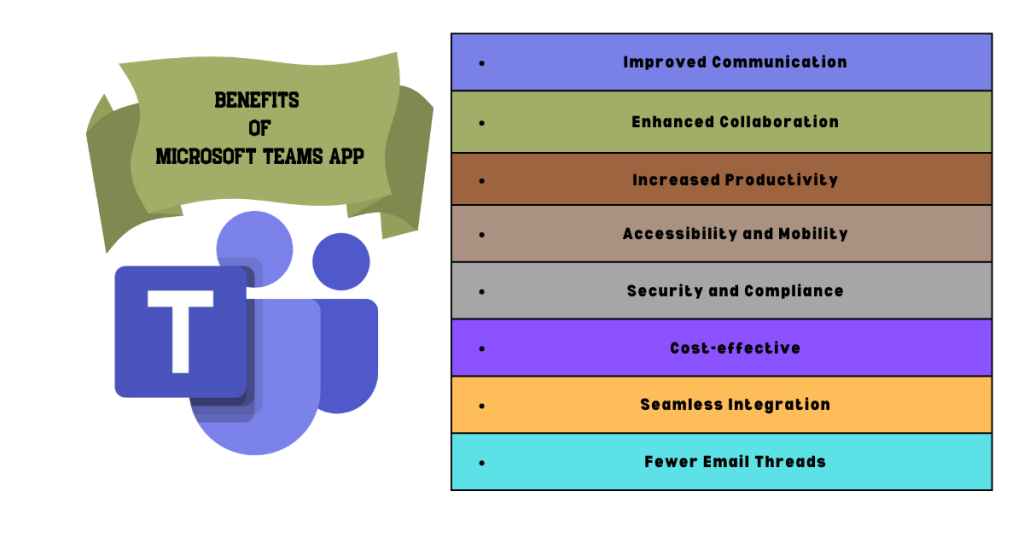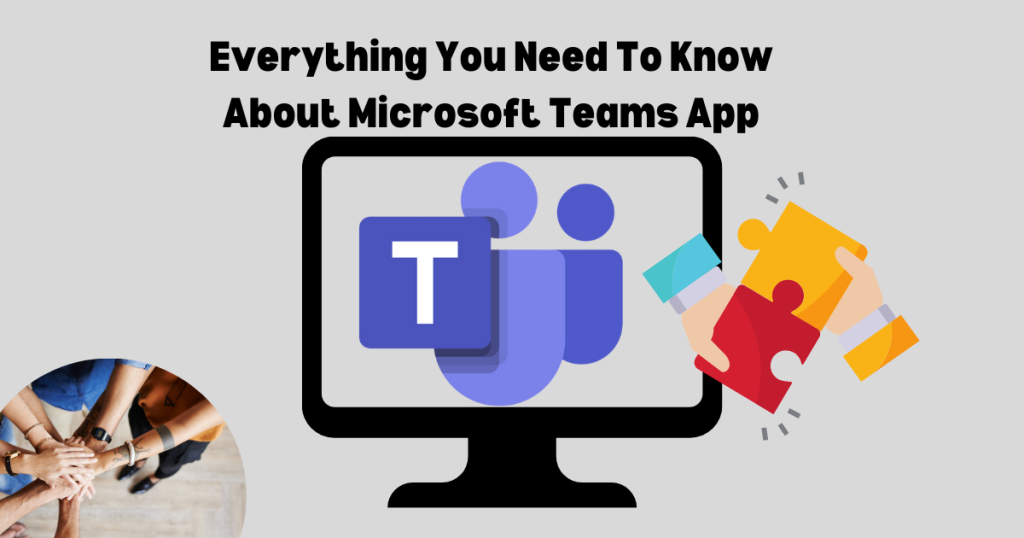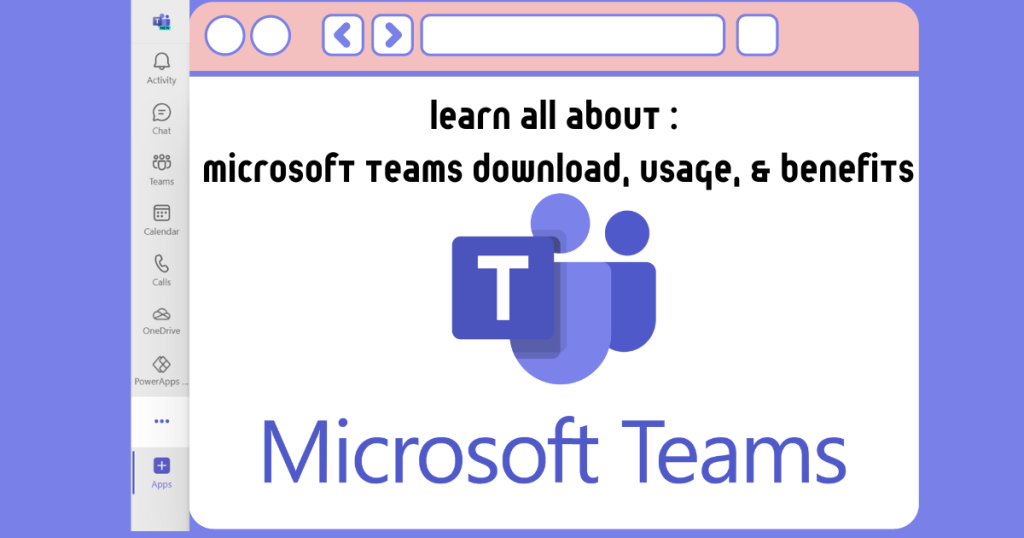Microsoft Teams app is a cloud-based collaboration platform designed for real-time communication and information sharing within organizations.
It functions as a central hub, offering a comprehensive suite of features to enhance teamwork and streamline workflows.
The Teams app helps you in unlocking the full potential of your meetings by making them more interactive, engaging, and productive.
Last but not least, Microsoft Teams helps in real-time problem solving by bringing content and data from apps into meetings, collecting feedback, and accelerating decision-making.
Key features of Microsoft Teams App
| Communication and Collaboration | Teams facilitates communication through persistent chat channels, enabling threaded conversations and information exchange among team members. It also supports direct messaging for private communication. Moreover, it helps in maintaining post-meeting engagement by circulating notes and results captured by the apps. |
| Organization and Task Management | Integration with task management tools like Planner and To Do allows teams to create, assign, and track tasks directly within Teams. This fosters accountability and ensures everyone is aligned on project goals and individual contributions. |
| Video Conferencing and Meetings | The platform allows users to conduct online meetings with video conferencing capabilities. Features include screen sharing, file sharing, and real-time collaboration tools like Microsoft Whiteboard. |
| Security and Accessibility | Modern Authentication protocols and multi-factor authentication (MFA) ensure only authorized users can access Teams and organizational data. Additionally, Teams meetings are protected with features like lobby bypass restrictions and attendee controls. |
| File Sharing and Co-authoring | Teams integrates with cloud storage services like OneDrive and SharePoint, enabling seamless file sharing and co-authoring of documents. Team members can access, edit, and share files within the platform itself. |
Overall, Microsoft Teams provides a unified platform for communication, collaboration, and information sharing, promoting efficient teamwork within organisations.
Benefits of Microsoft Teams App
Microsoft Teams offers a comprehensive suite of features that enhance communication, collaboration, and task management within organizations.
- Unified Communication and Collaboration Hub:
| Centralized Platform | Teams consolidates communication channels (chat, meetings, calling), file storage (OneDrive, SharePoint), task management tools (Planner, To Do), and project discussions into a single platform. This reduces context switching and improves team focus. |
| Enhanced Visibility & Communication | Real-time messaging, video conferencing, and persistent chat channels enable open communication and information sharing. Team members gain improved visibility into project progress, deadlines, and task assignments. |
- Streamlined Task and Project Management:
| Integrated Task Management | Integration with tools like Planner and To Do allows for creation, assignment, and tracking of tasks directly within Teams. This fosters accountability, aligns team members with project goals, and simplifies task management workflows. |
| Improved Project Oversight | Dedicated channels for projects centralize project discussions, files, and tasks. This provides stakeholders with a clear view of progress, milestones, and decision-making processes. |
| Real-time Document Collaboration | Microsoft Office 365 integration allows for real-time co-authoring of documents within Teams. This eliminates version control issues, streamlines editing processes, and ensures everyone works on the latest version. |
- Increased Efficiency & Productivity:
| Reduced Email Clutter | Centralized communication and collaboration tools minimize reliance on email, reducing clutter and improving workflow efficiency. |
| Streamlined Workflows | Teams automates repetitive tasks and simplifies information access, leading to increased productivity for individual team members and entire organizations. |
| Enhanced Remote Team Management | Video conferencing, file sharing, and real-time messaging enable effective communication and collaboration for geographically dispersed teams. |
- Security and Accessibility:
| Robust Data Security | Data encryption (in transit and at rest), user authentication/authorization (MFA, RBAC), and Data Loss Prevention (DLP) safeguard sensitive information and ensure compliance with security regulations. |
| Secure Meetings | Secure meeting features like lobby bypass restrictions and attendee controls prevent unauthorized access and protect confidential discussions. |
| Centralized Security Management | The Microsoft 365 Security Center provides administrators with security posture overviews, threat detection, and reporting tools for proactive risk management. |
| Comprehensive Accessibility Features | Screen reader support, keyboard shortcuts, live captions/transcripts, high contrast mode, color themes, magnifier, and support for live captions/sign language interpretation ensure an inclusive environment for users with diverse needs. |
In conclusion, the Microsoft Teams application offers a multitude of benefits for organizations.
It fosters a secure, efficient, and collaborative work environment through its unified communication platform, streamlined task management functionalities, and commitment to robust security and accessibility features.

How to get started with Microsoft Teams App
Getting started with the Microsoft Teams app is divided into multiple steps which are as follows:
Prerequisites:
- An active Microsoft 365 subscription that includes Teams functionality.
- An internet connection.
- A compatible device (computer, smartphone, tablet).
Step #1: Application Installation
- Desktop users should locate the Microsoft Teams application within their organization’s software distribution platform (e.g., Microsoft Endpoint Manager/M365 Portal).
- Mobile users should access their device’s application store (e.g., Apple App Store, Google Play Store) and then search for “Microsoft Teams.”
- Initiate the installation process according to your desktop/device’s requirement.
Step #2: Initial Login
- Launch the Microsoft Teams application.
- Enter your organizational Microsoft 365 username and password.
- If prompted, complete any required multi-factor authentication (MFA) steps.
Step #3: Team Discovery and Joining
Teams can be categorized into two main types:
- Public Teams: Discoverable by all users within an organization. You can join these teams directly through the Teams application search function.
- Private Teams: Require an invitation from a team owner or member. You will receive a notification within Teams when an invitation is available.
Step #4: Exploring the Teams Interface
- Teams: Lists all the teams you are a member of.
- Chats: Provides access to direct and group messaging functionality.
- Calendar: Enables scheduling and management of meetings and events.
- Calls: Facilitates voice and video calling functionalities.
- Files: Offers access to cloud-stored files and collaboration tools.
- Apps: Provides integration with various third-party applications and Microsoft services.
Step #5: Customizing Settings
- Access the Settings menu within Teams to personalize your user experience.
- You can customize notification preferences, accessibility settings, and keyboard shortcuts.
Step #6: Creating a Team
- Launch the Microsoft Teams application.
- In the left navigation pane, locate and click the “Teams” icon.
- At the top of the “Teams” list, click the “Join or create a team” button.
- Select “Create team” from the displayed options.
Creating a Team from Scratch:
When you decide to create a Team from scratch, choose between:
- Private: This creates a team where only specific members you invite can join.
- Public: This creates a team discoverable by anyone in your organization, allowing them to request membership.
- Enter a Team name that clearly reflects the team’s purpose.
- (Optional) Add a Team description to provide additional context about the team’s function or goals.
- Click the “Create” button.
Adding Team Members:
- In the “Add members” section, start typing the names or email addresses of individuals you want to invite to the team.
- Select the appropriate users from the search results.
- You can choose their role within the team: Owner (full access and permissions) or Member (standard access).
- Click the “Close” button once you’ve added all desired members.
Note: Specific functionalities and configurations within the Teams application may vary depending on an organization’s Microsoft 365 subscription plan and administrator settings.
Microsoft Teams app is an all-in-one application that connects you with other people online. With the help of Microsoft Teams app, you can share content, meet, and chat with people from all around the world.
Limitations of Microsoft Teams App
Microsoft Teams, while a powerful collaboration tool, does have some limitations to consider. Here’s a breakdown of some key areas to be aware of:
| Limited Customization | Teams offers a professional interface, but customization options are limited. Branding elements specific to your organization might be difficult to integrate. |
| Integration Challenges | While Teams integrates well with Microsoft products, incorporating external applications can be complex. This may disrupt workflows if your organisation relies on various non-Microsoft tools. |
| Performance and Scalability Concerns | Large teams with extensive data sharing may experience performance issues like slow loading times or lag. |
| Usability Learning Curve | The feature-rich interface can present a steeper learning curve for new users, potentially hindering initial adoption and user satisfaction. |
- You may also be interested to read : SharePoint vs OneDrive – Choosing The Right Tool
FAQs
How can I use Microsoft Teams on my mobile?
Install the Microsoft Teams app on your mobile. Sign in by entering your organisational Microsoft 365 username and password. Now you’ll see a list of all the Teams you’re a member of. Tap on a team to access its channels, conversations, and files. .
How to install Microsoft Teams on Windows?
Installing Through Microsoft Teams Website
- Open a web browser.
- Navigate to the official Microsoft Teams download page: https://www.microsoft.com/en-us/microsoft-teams/download-app
- Click the “Download for desktop” button.
- On the next screen, choose the appropriate download option based on your needs:
- “Download Teams”: This downloads the installer for users with a Microsoft 365 work or school account.
- “Get the free app (for personal use)”: This downloads the free version of Teams suitable for personal use and collaboration.
- Click the downloaded file (typically named “Teams_windows_x64.exe”).
- Follow the on-screen instructions during the installation process. This might involve accepting licence agreements and choosing an installation location.
- Once the installation is complete, you can launch Microsoft Teams from your Start menu or desktop shortcut.
What is Microsoft Teams’ worst feature?
Identifying the absolute “worst” feature of Microsoft Teams can be subjective, as different users prioritise different functionalities. What may be the worst feature for one user, may be the best feature for another. So to label one specific feature as the worst would not be fair or accurate.
How to Use the Inspection App in Microsoft Teams?
- Launch the Microsoft Teams application.
- Navigate to the desired Team where the Inspection App is installed.
- Look for the “Inspection” tab within the Teams channel.
Performing Inspections:
- Click on the “Inspection” tab.
- You’ll likely see a list of pre-defined inspection forms or templates relevant to your team’s needs.
- If your team uses custom forms, these will be displayed here.
- Select the appropriate inspection form you want to use.
- A preview of the inspection checklist will typically be displayed. This might include sections, questions, and answer options specific to the chosen form.
- Click on the “Begin Inspection” button to initiate the data collection process.
How do I join the Microsoft Teams meeting on a Mac?
There are two main ways to join a Microsoft Teams meeting on a Mac:
1. Joining from a Meeting Link:
This is the most common way to join a Teams meeting.
- Locate the meeting invitation: You’ll likely receive an email or calendar invite containing a link to join the Teams meeting.
- Click the “Join Microsoft Teams Meeting” link within the invitation.
- Choose how you want to join: A pop-up window will appear with two options:
- “Open Microsoft Teams”: This will attempt to launch the Microsoft Teams application on your Mac if it’s installed.
- “Join on the web”: This will allow you to join the meeting directly in your web browser without needing the Teams app installed.
2. Joining Through the Teams App:
If you already have the Microsoft Teams application installed on your Mac, you can join a meeting directly through the app:
- Launch the Microsoft Teams application.
- Navigate to your calendar: In the left navigation pane, click on the “Calendar”icon.
- Find the meeting: Locate the meeting you want to join in your calendar view.
- Click the meeting: Click on the meeting to open its details.
- Join the meeting: Click the “Join” button.



